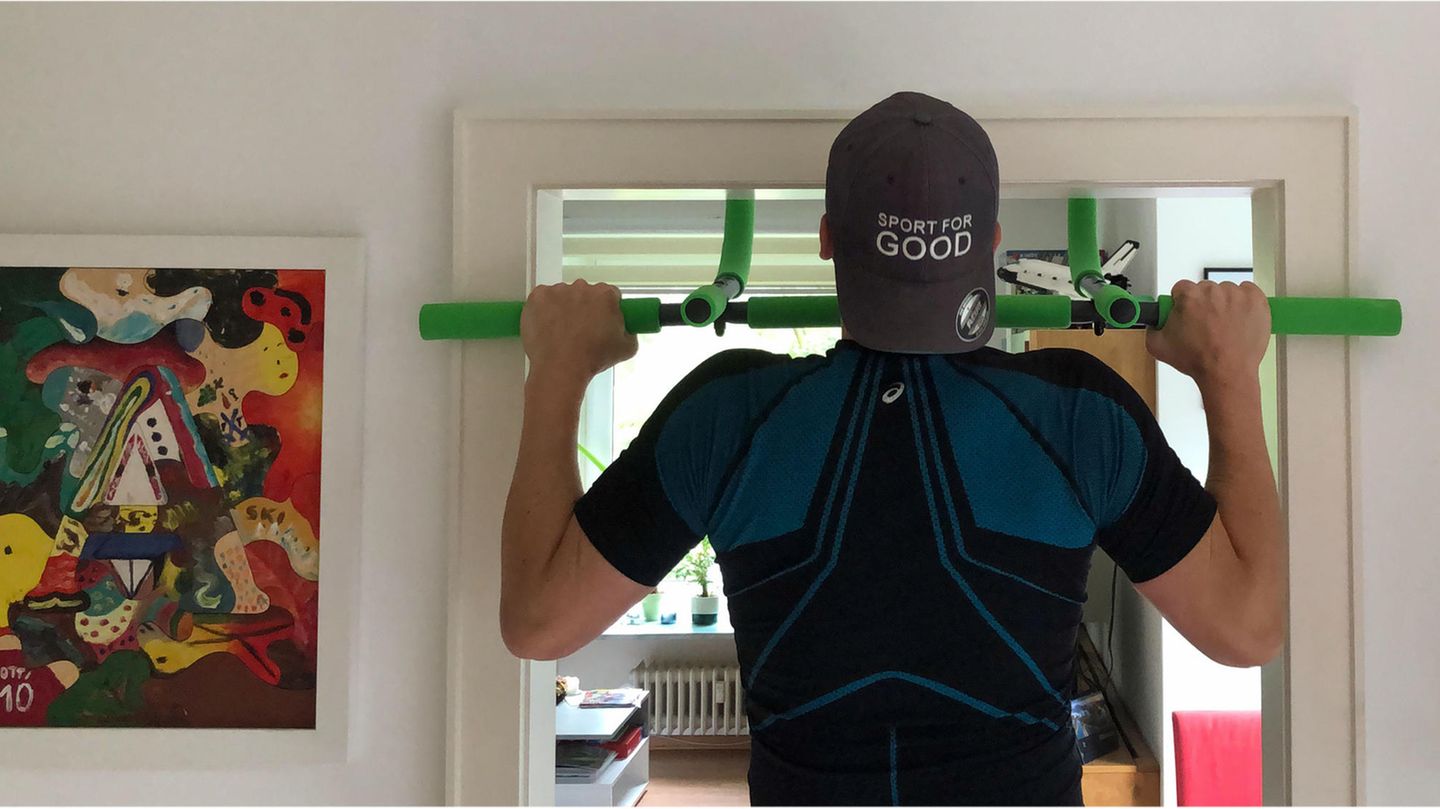Practical test
If you don’t believe in the gym and prefer to work on your fitness at home, you need versatile and practical equipment. Pull-up bars for the door seem to be just the thing for this. the stern put three models to the test.
If the walk to the gym is too far for you or the membership fee is too steep, you have two options: let it hang or hang in. For the latter, mobile pull-up bars at home seem to be a practical option. But what can the small fitness equipment do? Do the stakes keep what the manufacturers promise? the stern has taken a close look at three current models and put them to the test.
1. Springo’s pull-up bar
Overview of key data
- Weight: 1.047 g
- Length Width: 60-101 cm
- Max. Handle width: 51 cm
- Circumference at the handle: 13 cm
- Max. Load: 100 kg (according to manufacturer)
- Scope of delivery: Backrest, 2 rubber rings + screws
- User Manual: English / Polish
The first impression
the comes in an unadorned cardboard box. This contains the rod wrapped in cling film, a small bag with two rubber rings and two small screws (optional attachment). The operating instructions are more than spartan. It consists of exactly one A4 sheet of paper. Logically, you don’t find out much in it. You should also be able to speak the English language. The bar itself makes a solid impression. The black and red handle pads made of synthetic rubber are pleasantly wide. The weld seams on the end pieces of the pull-up bar are not quite as trustworthy. At least one side of our test product was not worked properly. If you are looking for and need small exercise examples for strength training, you should not dispose of the packaging. There are five exercises with tips on it – from the simple holding position to sit-ups. Of course also in English.
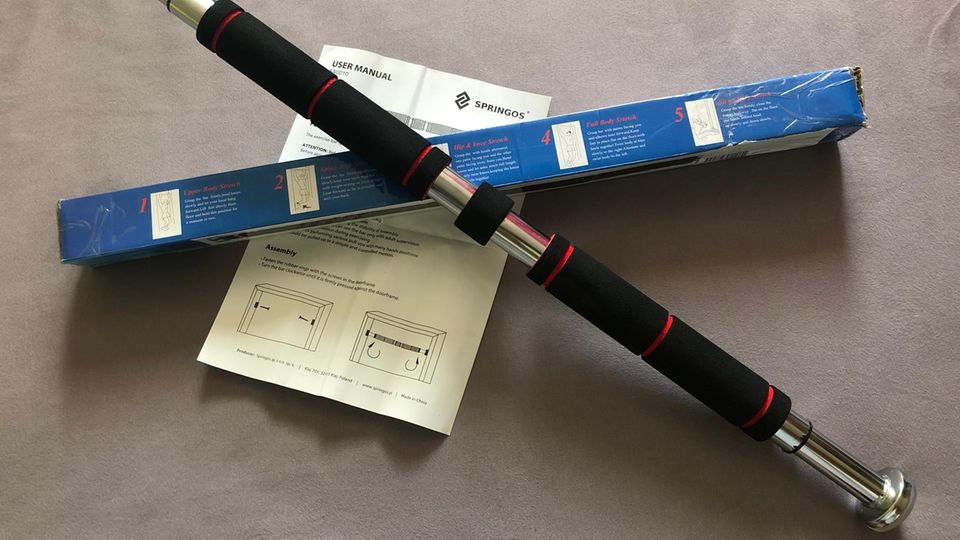
The test
The bar is installed in a door frame in a few minutes. To do this, the two ends are screwed out evenly, as with a telescopic rod, until the rod jams by itself. Attention: A left-hand thread is installed on one side. The training device is finally fixed by placing the rod on the handle handfest attracts. This is especially important with older doors and door frames. Because: The tighter the bar is tightened, the more pressure the frames have to withstand. If you want to make sure that the rod is exactly horizontal, it is best to use a tape measure or a folding rule before finally fixing it. The pull-up bar is ready for use. And keeps what the instructions promise. When subjected to a load of around 80 kilograms, the steel rod held tight and did not move a millimeter. She had to withstand a few pull-ups and simple holding exercises in the practical test. The cushions are easy to grip, even with sweaty hands there is no risk of slipping. And the door frames also remained intact in our test. The hard rubber stoppers on the end pieces didn’t leave any unsightly marks.
Conclusion
The Springos pull-up bar is not a high-end training device. At a price of less than 20 euros, that wasn’t to be expected. Apart from a poorly processed weld seam, the steel bar makes a decent impression. It is attached quickly and easily and had no problems with the pull-ups of the 80 kilo tester. For beginners in home workouts, a more detailed map or brochure with some exercise examples and tips would be desirable.
2. Schildkröt multifunctional door bar
Overview of key data
- Weight: 2.228 g
- Length Width: 101,5 cm
- Max. Handle width: 75 cm
- Circumference at the handle: 13 cm
- Max. Load: 100 kg (according to manufacturer)
- Scope of delivery: Door bar (disassembled), multifunctional tool
- User Manual: German and 14 other languages
The first impression
If a successful top athlete recommends fitness equipment, that should mean something. Arnd Peiffer, Olympic champion and one of the most successful biathletes in recent years, is the testimonial of Schildkröt Fitness and adorns the packaging of the . A guarantee of quality? Well, optically the fitness machine makes a very valuable impression for your own four walls. The package includes four steel rods padded with green polyurethane, multilingual (construction) instructions as well as screws, nuts and a suitable multifunctional tool for assembly. With the help of the instructions and a little manual skill, this is a matter of a few minutes. The screwed-together mobile fitness device, which was designed both as a pull-up bar and for strength training on the floor, weighs a little more than two kilograms. A brochure with exercise examples is not included. As with the other two devices, you have to make do with exercise suggestions from the Internet. Small minus point.
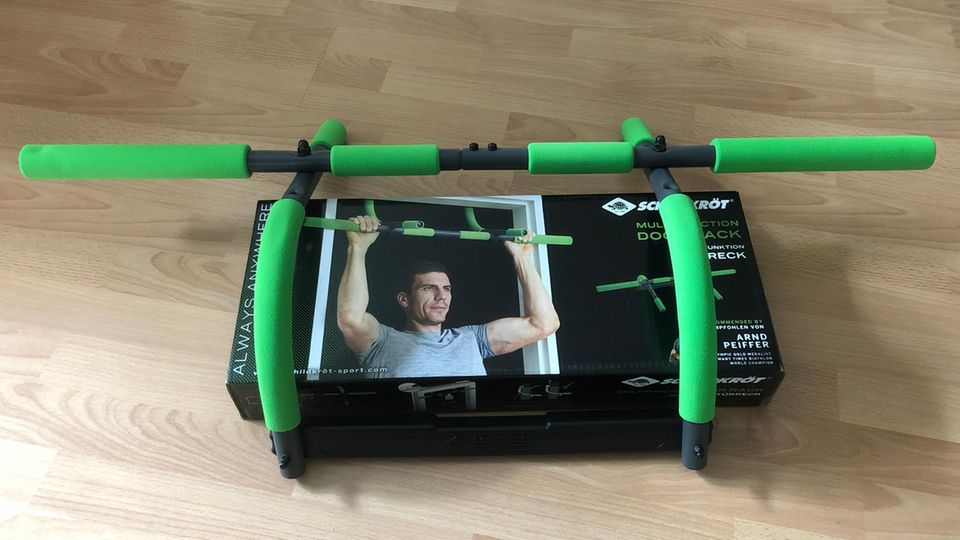
The test
In order to avoid a nasty surprise, the depth of the door frame should be measured before screwing together (or even better: before buying). It should be between twelve and a maximum of 24 centimeters. Otherwise the door bar cannot be securely fixed in the frame. In our case, we came to just under 18 centimeters. With the middle holes, the door bar fit perfectly. Tip: Before the metal brackets are fixed to the crossbar, stop both on the door frame in order to find the correct position and drill hole.
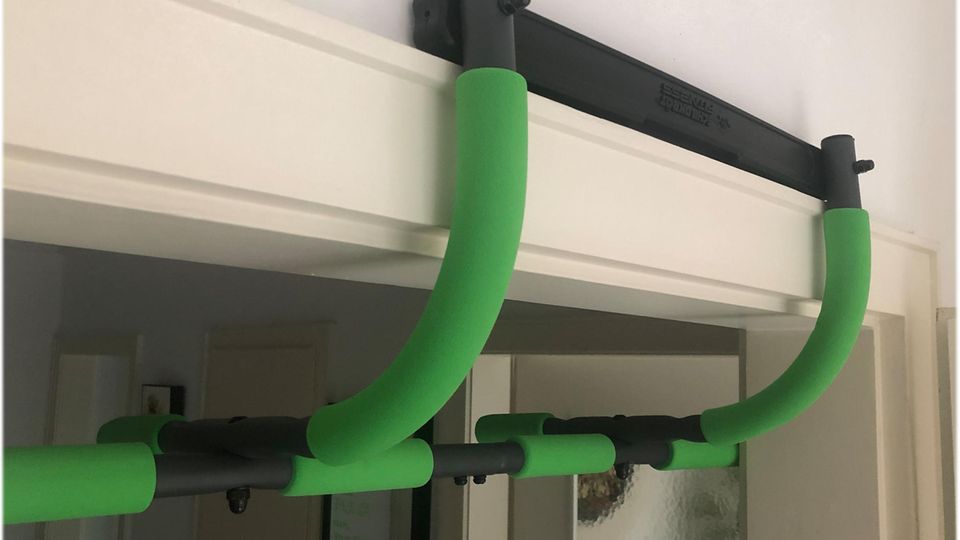
Ultimately, the Schildkröt multifunctional door bar with the cross member made of PVC is placed on the upper edge of the door frame. On the other side of the door, the two ends of the crossbar press against the door frame (see picture). Now you can train. Pull-ups worked without any problems with a tester weighing 80 kilograms. The horizontal bar sits bombproof. You can pull with the classic handle as well as with the short handlebars. The green grip pads are comparatively soft and hardly structured. With sweaty or wet hands, the grip was not optimal in our test. The ends of the pull-up bar, which are also padded, protect the door frame from scratches. For strength exercises such as sit-ups or push-ups, the door bar must be placed on a gymnastics or yoga mat, carpet or other dull floor covering. The device slips away during training on laminate, tiles or parquet and, in the worst case, scratches the floor.
Conclusion
Versatile and solidly constructed training device for the home. The assembly is simple, the material is stable. In contrast to the telescopic pull-up bars, the door bar does not fit into all door frames. You can also use it to train your abdominal, core and shoulder muscles on the floor. Clear advantage. The price: The Schildkröt door bar is significantly more bulky than the simple bars to clamp. Another disadvantage: It is not a permanent solution. Unless it is installed in a doorway without a door, because it will not close when the device is hanging in the door frame. The PVC upholstery is a bit too thick and soft for our taste. This is at the expense of grip. For less than 30 euros, the Schildkröt-Türreck is a good investment for anyone who wants to do something for their fitness at home.
3. Sveltus pull-up bar
The key data at a glance
- Weight: 1.075 g
- Length Width: 79,5 cm
- Max. Handle width: 48 cm
- Circumference at the handle: 12,5 cm
- Max. Load: 100 kg (according to manufacturer)
- Scope of delivery: Backrest, 2 rubber rings + screws
- User Manual: English
The first impression
Similar to the rod of Springos, the Supplied in a narrow cardboard box to save space. The content is also almost identical. In addition to the steel rod itself, there is a small bag with two rubber rings and screws for optional fixing in the door frame. There is also a one-page user manual in English. There you can find out in a nutshell how the pole should be assembled. There are also four exercise examples on the back. What else do you notice? The two grip pads were each provided with four notches, which should probably provide a better grip. The seam on the end pieces is neat and the black rubber seals that are supposed to protect the door frame fit perfectly. Somewhat strange: the packaging states that the maximum load is 100 kilograms. The user manual speaks of a “maximum body weight” of 120 kilograms.
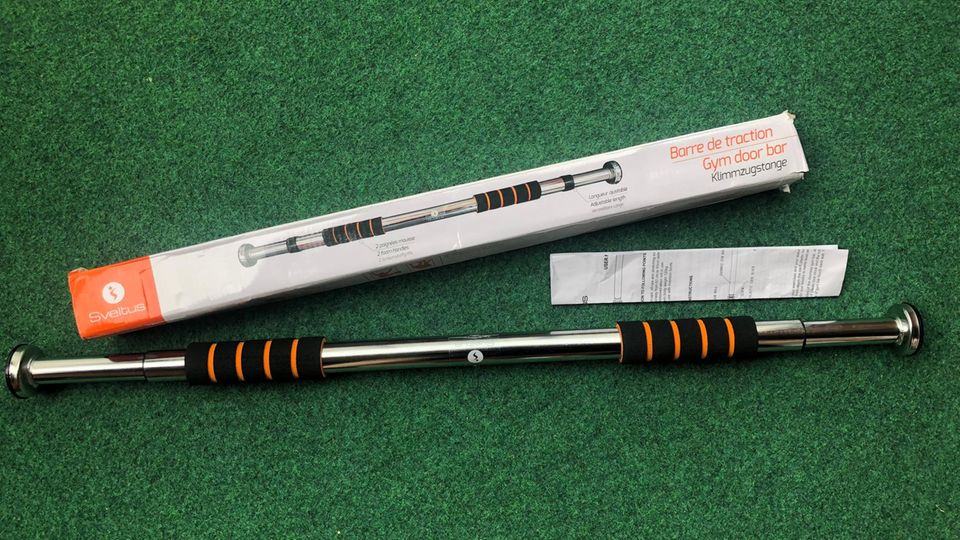
The test
The principle of the telescopic pole is simple. And it works. The rod is adjusted via the rotatable end pieces so that it holds in the door frame, whereby one side also functions with a left-hand thread. For a secure hold, the handle with the two cushions must then be carefully tightened. The principle also applies here: After solid comes broken. At the latest when it creaks in the frame, the rod should be securely fixed. In our test, the bar withstood the tester’s approximately 80 kilograms without complaints. The intelligently structured cushions with the notches are easy to grip. Pull-ups and longer slope exercises weren’t a problem even with wet hands. And here, too, the rubberized dropouts left no traces or pressure marks on the light-colored frame.
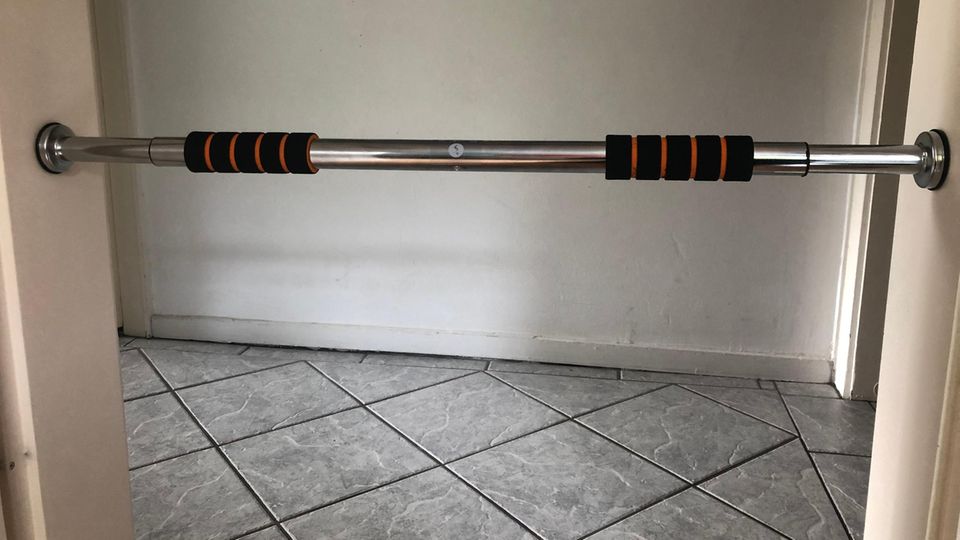
Conclusion
The pull-up bar from Sveltus appeared to us in the test a tad better thought-out and better processed than the competitor product from Springos. The grip pads are cleverly designed and the device gives an overall impression of being stable. For beginners, more detailed tips on exercises would be desirable here as well. In our opinion, a sparsely printed leaflet is not enough. However, the bar easily withstood the pull-up test. And that is exactly what the reasonably priced fitness device from the French brand is for.
This article contains so-called affiliate links. There is more information here.
I have been working in the news industry for over 6 years, first as a reporter and now as an editor. I have covered politics extensively, and my work has appeared in major newspapers and online news outlets around the world. In addition to my writing, I also contribute regularly to 24 Hours World.

